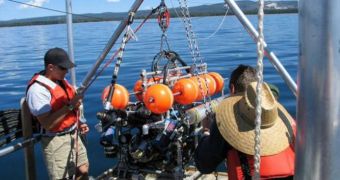The first ever investigation to look in close detail at the hydrothermal vents on the bottom of the Yellowstone Lake has determined that the structures are teeming with life.
By definition, thermal vents are extremely hostile environments, mostly due to the fact that this is where hot gases from the Earth's mantle are released into seas or oceans.
This causes the temperature levels near the sites to soar, and the area to get contaminated with a myriad of poisonous chemicals. But this apparently cannot stop life forms from thriving atop the vents.
Researchers have analyzed hydrothermal vents in the past, but those at the bottom of Yellowstone Lake were not investigated until recently. Moss, worms and shrimp were among the most common species found at the bottom of the lake.
The lake floor contains hundreds of small vents, which create a water temperature of around 90 degrees Fahrenheit, or 32 degrees Celsius, warmer than most waters, Our Amazing Planet reports.
The vent that was analyzed in this new investigation is located a third of a mile offshore of the West Thumb region of Wyoming, some 100 feet (30 meters) below the surface of the lake.
It was discovered that it is surrounded by about 0.6 meters (2 feet) of moss, among which many shrimp and worms carried out a peaceful existence.
“This particular vent seemed unique relative to all other active vents thus far observed in the lake in that it is robustly colonized by plants,” the team behind the investigation writes.
Experts used a Remotely Operated Vehicle (ROV) submersible to conduct the survey, which discovered species of worms that scientists did not know existed in North America.
The group also found out that Fontinalis moss endures in far more extreme conditions that originally thought. The main issue with plant life around vents is the absence of light.
But the moss appears able to find and make good use of whatever light does make its way to the deep, explains Montana State University in Bozeman study team member John Varley.
Additional details of this amazing investigation can be found in the September issue of the esteemed scientific journal Geobiology.

 14 DAY TRIAL //
14 DAY TRIAL //